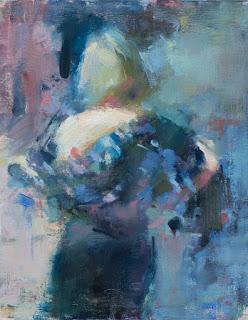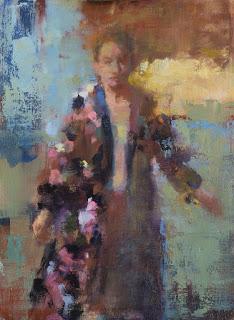
Oil with cold wax

Oil on textured board

Oil on multi-colour, toned linen
My favorite paintings are the ones that hide parts of themselves, forcing viewers to finish ambiguous areas with their imaginations. I also love rugged textural surfaces that allow underpainting to show through in surprising glimpses. Vuillard was a master at this way of painting as was the recently departed Bernard Dunstan. But oil paints are manufactured to be smooth and buttery which means that it's pretty much impossible to create the type of surface that I long for without trickery and additives.These 3 pieces come close to achieving my aims (no painting is ever what I'd hoped it would be) and they all do it a bit differently.
In the first piece, I mixed a bit of Gamblin's Cold Wax into the paint and applied it with both brush and knife, making sure to work dryly. It's fine to add some more fluid medium to the wax and paint, but I find that it defeats the purpose of the wax - at least for me. Wax allows a complex building of layers as well as giving the opportunity for beautiful, smoky, soft effects when it's flattened gently with a palette knife. You can see that atmospheric blurring in the bottom of the shawl and in the background.
The second piece has a lot in common with the surface of the first, but I did it without any wax. The key to this one was using the paint without any medium at all, and working on a board that had some texture to it. In this case, the texture was a simulated weave effect that I achieved by brushing on acrylic gesso in one direction, letting it dry, and then brushing on another coat with the strokes crossing the first. I like to put on about 4 coats and, by using a stiff, house painting brush, I can get some significant texture on the support. This is what grabs the paint in a broken fashion, both from the brush, and the knife. If the paint were fluid, it wouldn't work; it would flow into the dips in the gesso, filling them up, rather than sitting on the peaks. This broken layering is especially clear in the area beside the elbow on the left. Light blue paint was spread over top of dark blue while both were wet, but the dark was applied with a more solid, scrubby application, and the light with a swipe from a loaded knife. Because I didn't force the paint down into the dips, and because it wasn't fluid at all, I could preserve those little windows of dark blue, and get a real sense of depth. It was a happy accident.
The final painting is a larger one, done on portrait grade linen. That's a smooth, rather slick surface and easily gets clogged with paint, especially in alla prima work. In this case, I did add a bit of 50/50 stand oil and OMS to the paint, but not much, and I kept the paint application generally thin and broken, using hog bristle brushes. The underpainting was very colourful but completely dry when I started so there was no risk of new color blending into a ghastly mess with all that chroma. Working on dry toning, also helped me to create a sense of depth as the underpainting clearly sits behind the figure, not on the same level. The challenge with this piece is to cover enough, but not too much colour, and to build a robust paint body but not a monotonously thick one. I'm still tweaking this one, so it'll change in the future when I figure out what to do next.
Rembrandt used ground glass to add both texture and sparkle; marble dust is a common additive, and there are lots of impasto mediums to choose from which will help in overriding the homogenous buttery nature of modern paints. My choice is always to keep it simple and predictable, so, while I do try most mediums, I tend to drop them after a while because they make me nervous. I wonder, when picking up a dry piece to continue working it, if I've added this medium, or that one - if I've worked with a lean or a fat additive. By sticking to a couple of simple and intuitive mediums, I can usually figure out where I was in the painting process and carry on to create a painting that will age well.
Happy painting!

